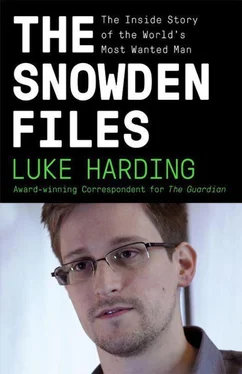There were intriguing clues as to how NSA operations work. Spying against France is listed under a secret codename, US-985D. Germany gets its own espionage codes, US-987LA and US-987LB. The programs include DRTBOX – used for data collection – and WHITEBOX, for recording content. Further clandestine acronyms are used to describe spying on French diplomats in the US. In Italy it was the same picture. The Special Collection Service that spied on Merkel was bugging the Italian leadership too, from embassy ‘sites’ in Rome and Milan. Italian metadata was ingested by the millions.
The French government’s response to this was double-layered. In what by now was a much-repeated ritual, the US ambassador to Paris, Charles Rivkin, was summoned to explain himself. François Hollande, the country’s struggling president, called Obama to remonstrate, while his foreign minister Laurent Fabius dubbed the affair ‘totally unacceptable’. ‘Rules are obviously needed when it comes to new communication technologies,’ France’s interior minister Manuel Valls said.
But French reaction was milder than in Germany, and more outrage than outrage. In June, Hollande had threatened to suspend transatlantic trade talks but overall his response was half-hearted, with his rhetoric aimed at domestic voters. One paper, Le Parisien , characterised it as ‘gentlemanly’. Everyone knew that France had its own spying operation, and was a leader in industrial snooping. More importantly, Paris was clearly keen to preserve good relations with Washington. That said, French politicians did seem genuinely stunned by the sheer scale of NSA trawling.
By this point the US was giving the same stock response to anxious allies around the world. The White House said that questions raised by France and other disgruntled Europeans were ‘legitimate’, adding that Washington was reviewing ‘the way that we gather intelligence’ so that ‘we properly balance’ security and privacy. On the other hand, Caitlin Hayden, the National Security Council spokesperson, said: ‘The US gathers foreign intelligence of the type gathered by all nations.’ In other words, ‘We spy on you and you spy on us. Get over it, dude.’
Director of national intelligence James Clapper – the man who misled Congress – said Le Monde had got its facts wrong. Clapper denied that the NSA recorded 70.3 million French phone calls. He gave no further details but seemed to imply that the NSA only scooped up the metadata. He suggested that western intelligence agencies were themselves behind much of this European spying.
In effect, the Europeans were hypocrites. Was Clapper right?
The answer – up to a point – was yes. Western intelligence agencies also spied, albeit with fewer resources than the NSA. They worked closely with the US intelligence community, and had done so for decades. Germany’s domestic intelligence body, the BND, for example, shared information with Fort Meade including metadata and had even handed over copies of its two digital spy systems, Mira4 and Veras. Snowden himself flagged these close connections, telling the journalist and internet freedom activist Jacob Appelbaum that the NSA was ‘under the same roof’ as the Germans, and ‘most other western states’.
The extent of this collaboration could be confusing. One BOUNDLESS INFORMANT slide, shared by Greenwald with the Norwegian tabloid Dagbladet , suggests the NSA is hoovering up 1.2 million Norwegian telephone calls daily. Norway’s military intelligence service, however, said the slide had been misread. It said Norway itself collected the calls from Afghanistan, and passed them on to Fort Meade. This claim, however, is difficult to reconcile with NSA’s own PowerPoint, subtitled: ‘The mission never sleeps.’ It makes clear that collection of metadata under the program is against a country rather than from it. There is a separate slide for each country, including Norway and Afghanistan.
The big picture was obvious. And troubling. With or without help, the NSA was sucking in everyone’s communications. One document seen by Le Monde said that between 8 February and 8 March 2013 the NSA collected 124.8 billion telephone data items and 97.1 billion computer data items. These figures were for the entire world. In an editorial the paper noted that new technology had made possible a ‘Big Brother’ planet. There were no prizes for guessing which nation played the role of Winston Smith’s nemesis.
The NSA’s core mission was national security. At least that was the idea. But by the end of 2013 it appeared that the agency’s intelligence-gathering operations were about something much simpler – global power.
Merkel, it transpired, wasn’t the only foreign luminary whose phone the NSA had hacked. An NSA memo from 2006, published by the Guardian , showed it was bugging at least 35 world leaders. The agency had appealed to other ‘customer’ departments such as the White House, State and the Pentagon to share their ‘Rolodexes’ so it could add the phone numbers of leading foreign politicians to the NSA’s surveillance system. One eager official came up with 200 numbers, including the 35 world leaders. The NSA immediately ‘tasked’ them for monitoring.
The NSA subsequently targeted other leaders as well, including the president of Brazil, Dilma Rousseff, and her Mexican counterpart Enrique Peña Nieto. On the face of things this tasking was bizarre, since both countries enjoyed positive relations with the US. Rousseff’s predecessor, the leftist populist Luiz Inácio Lula da Silva, had annoyed Washington by inviting Iran’s then president Mahmoud Ahmadinejad for a visit. After taking office in 2011, however, Rousseff sought to improve ties with the White House. She distanced herself from Tehran and hosted Obama, who had previously cancelled his Brazil trip.
The NSA wasn’t interested in these good vibrations; what interested US spies was Rousseff’s private thinking. An NSA slide obtained by Der Spiegel shows that analysts managed to get access to Rousseff’s messages. Fort Meade investigated ‘the communication methods and associated selectors of Brazilian president Dilma Rousseff and her key advisers’, Spiegel reported. It also discovered other ‘high-value targets’ inside her inner circle.
As well as bugging democratically elected leaders, the NSA was secretly targeting the country’s most important company, the state-run oil firm Petrobas. Petrobas is one of the 30 largest businesses in the world. Majority-owned by the state, it is a major source of revenue for the Brazilian government. It is developing several massive new oilfields, which are in a region deep under the Atlantic.
Files given by Greenwald to Brazil’s news programme Fantástico show the NSA managed to crack Petrobas’s virtual private network. It did this using a secret program codenamed BLACKPEARL. Other targets identified by BLACKPEARL include the Swift network for global bank transfers, the French foreign ministry and Google. A separate GCHQ document, titled ‘network exploitation’, suggests that UK–USA routinely targets the private network traffic of energy companies, financial organisations, airlines and foreign governments.
Unsurprisingly, Rousseff took a dim view of the NSA’s snooping, seeing it as an outrageous violation of Brazil’s sovereignty. The White House responded to her protests with generalities; it used the same template with the Germans and the French. In September, Rousseff announced she was cancelling her official visit to Washington, due to take place on 23 October. Obama called Rousseff in a vain attempt to get her to change her mind. In the absence of a ‘timely investigation… there aren’t conditions for this trip to be made,’ the Brazilian government said.
Читать дальше












